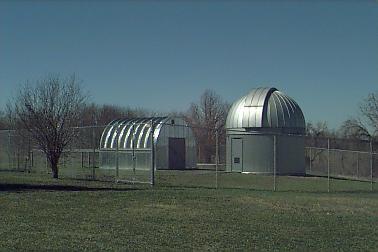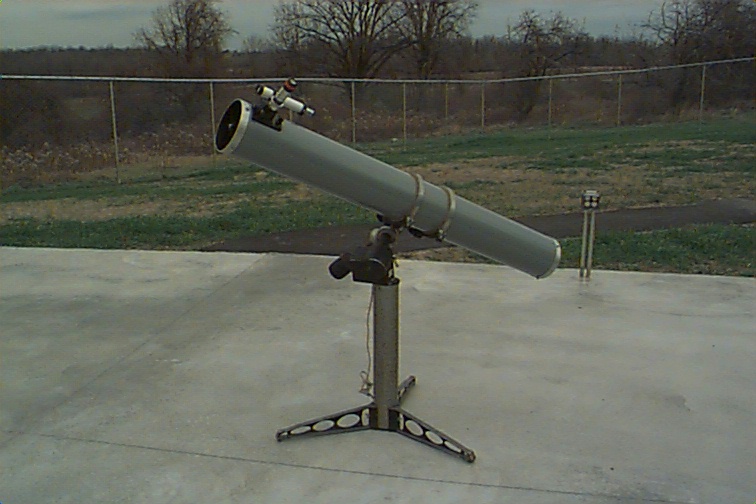
Our house sits on the west side of John Street at number 645, just north of the intersection with Bailey Road. The telescope buildings are behind the house, hidden from the road.
There are quite a few trees to the East and South of the telescopes, which block a portion of the sky -- but also block lights from the street. Here are rough values for the local horizon caused by the trees (based on measurements made Aug 20, 2003):
Instructions for using the Observatory:

This view from the pad looks northeast past the 5-meter Ash Dome and the roll-off structure built by Arch Technology.
Here is the roll-off building with the roof fully extended, from the southern end, and from the west.
We used to have a 16-inch f/15 Autoscope cassegrain reflector in this building, but its optics weren't very good, and it had such a long focal length (about 6000 mm) that its field of view was tiny. That made it very hard to find objects quickly, and so frustrated both telescope operators and people waiting to take a look.
So, in the winter of 2009, we installed a new telescope: a 14-inch f/10 Celestron. The telescope sits atop a big Astro-Physics German Equatorial mount which can be controlled by hand or by a computer.
On Aug 26, 2006, we added a set of mounting rails and rings from Scope Stuff so that we can mount a small telescope on the 12-inch to act as a big guider. I hope this will help us to find objects when we use cameras with very small fields of view. The first instrument we'll try is a 90mm f/5.6 (500 mm focal length) Maksutov from Pro-Optics; it should provide much wider fields than the 3000mm of the 12-inch. We have some other small telescopes we can try, too.
The Meade 12-inch telescope lives inside this 5-meter Ash Dome.
A 8-inch f/5 Dobsonian (property of the RIT
Astronomy Club
a Meade Starfinder 6-inch f/8 Newtonian (generously donated by Mr. Tim
Thompson),
 and
a 6-inch f/10 Newtonian (on loan from J. Kern).
and
a 6-inch f/10 Newtonian (on loan from J. Kern).
The SkySentinel Allsky Camera Network places video cameras with fisheye lenses at many locations across North America in order to monitor the sky for bright meteors. If the same object can be detected by cameras at three or more locations, its trajectory can be measured accurately using trigonometry.
We have one of these devices on the Observatory grounds. It takes pictures of the sky from dusk to dawn. Special software provided by the project searches the video for fast-moving objects, and sends information on candidates to a central archiving system. You can see the latest candidates from our camera at the RIT recent candidates page.
For certain purposes, most notably occultations of stars by asteroids, it is important to have precise measurements of the time of an event. Kiwi Geoff has designed an On-Screen Display (OSD) unit which takes time signals from a GPS receiver and writes timestamps on each frame of a video signal.
During the Winter Quarter, 2004-2005, RIT physics major Matt Montanaro did an independent study project in which he put together two of the KIWI OSD units. You can read his report -- which includes a complete part list! -- in several formats:
We weren't able to test the unit on the sky during the winter quarter, due to very bad weather, but we are looking forward to doing so as clear skies return in the spring.
These are very rough, but may help one to make plans for using our cooled CCD cameras: an SBIG ST-8E and an SBIG-ST9.
16-inch 12-inch
f/15 f/10 f/10 f/6
-------------------------------------------------------------------
unfiltered
ST8 3x3 120sec 17-18
ST9 1x1 20sec 15-16
V filter
ST8 3x3 30sec 16-17
-------------------------------------------------------------------
Notes:
Jul 02, 2005: 16-inch f/15 + ST9 unfiltered, 20-sec exp
yields scatter 0.10 mag for V ~ 15.5 star
There are also several pages describing the limiting magnitude of our video cameras under particular situations.
Back to RIT Observatory homepage